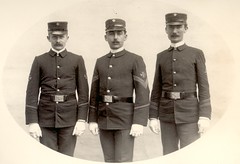Fort Bridger, Utah
August 24th 1868.
Sir:
In reply to your communication dated January 14th 1868, concerning specimens for the Army Medical Museum, I will state that opportunities of observing the results of “injuries + surgical diseases of the lower animals” at this post are very limited + nothing has come under my observation since the date of your letter that could be contributed to the section of the Museum illustrative of the subject.
Large wild game such as buffalo, elk, deer, antelope +c, are not found in this immediate vicinity + such is very seldom indeed brought to the post.
As a consequence of the scarcity of game no bands of Indians camp near hear except during a short time in the early summer when they collect to receive annuities, + are soon off for their fishing and hunting grounds again. I have not known of the death of an Indian in this locality since I have been stationed at the post – hence have had no opportunity of collecting crania.
During the present summer I have obtained specimens of bows + arrows from three tribes that have passed through the post – the Shoshone, Bannack + Ute – the weapons will be sent to the museum by Express + it will be observed that there is much similarity in those of the three tribes – all of them roving over the country in different direction within 200 miles of the post. The bows of all are usually made of the bow of oxyokes obtained along the several emigrant routes through the country. When first obtained they are soaked in hot water until they become pliable, + are bent into their present shape, reversing the curve as found. The component curve in the middle of the bow is thus easily obtained. The front or outer part of the bow is then curved with shreds of tendons obtained from along the spine of their game – either deer or buffalo. This is securely fastened on, as will be observed, by glue, which the Indian makes from the hoof or horn of the game. The elasticity of the bow is increased in this way.
The strings they make of tendons also.
The specimen of the Shoshone bow is one of the finest I have ever seen both as regards finish and springs. The remark about the similarity of the bows will apply also to the arrows. Those of the Utes are shorter than the arrows of either of the other tribes + the feathers extend along a greater proportionate length of the arrow. The grooves along the arrows are not made of a uniform curvature, but with these three tribes, they will be found much more tortuous than on the arrows of the Sioux, Cheyenne + Arapahoes, who roam on the Eastern slope of the Rocky Mountains. The grooves in their arrows are nearly straight. The object of these grooves is to facilitate the escape of blood while the arrow remains in the body of the animal.
The feathers on the arrows in these specimens, it will be seen, are fastened only at the extremities. On the arrows of some tribes they are attached the entire length of the feathers by glue.
The base of the arrow heads of these tribes are never bearded, + in some instances, as in the forwarded specimens of the Ute arrow, the slope of the base is in the opposite way, as if to facilitate its removal from the body. The Sioux, I am informed make their arrow heads more or less bearded. The round pointed arrows are used in shooting small games such as rabbits, birds, prairie dogs +c
The tomahawk sent is a weapon not often carried by the tribe from which I obtained it + the buck who had it, displayed it from his quiver more as an ornament than otherwise. These instruments are made in the East and sold to the Indians by traders. The specimen I forwarded is made to be used as a pipe, but it is of doubtful utility in that respect + seems not to have been used as such by the owner.
I send also a specimen of a Navajo arrow said to have been poisoned. A dark substance may be observed adhering to the arrow just above the head.
This description of the articles sent may not be desired but as it may not be entirely devoid of interest to yourself or to others, I have thought it best to give it.
The articles I have forwarded were purchased of Indians for cash to the amount of twenty-seven dollars. This may be regarded as an unreasonable expenditure for things of so little intrinsic value, but in consequences of the liberal prices they always obtain for every thing they sell at this post, I was unable to get them at a lower rate.
In the same package I send the bones of a fractured elbow joint from the accidental discharge of a gun loaded with eleven buckshot, the muzzle being within a few inches of the part at the time of the discharge of the piece. If a report of the case is desired I will be very happy to furnish it.
Very Respectfully
Your Obt. Servant
W. E. Waters,
Asst. Surg. U.S. Army
Bvt. Lt. Col. Geo. A. Otis
Asst. Surg. U.S. Army
Surgeon General’s Office
Washington, D.C.
